TOM CRUISE BIOGRAPHY – AGE – CAREER – NET-WORTH
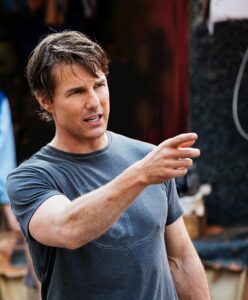
Tom Cruise was born Thomas Cruise Mapother IV on July 3, 1962, in Syracuse, New York. From a young age, his life was destined to defy the ordinary. Raised in a Catholic household with three sisters, his early years were turbulent, marked by financial instability and a strained relationship with his abusive father, Thomas Cruise Mapother III. His mother, Mary Lee Pfeiffer, was a special education teacher who provided emotional strength and a sense of direction. When Tom was 11, his parents divorced, and he moved frequently due to his mother’s struggle to support the family, attending over a dozen schools across the United States and Canada.
Despite his dyslexia, which made academics difficult, Cruise found refuge in performance. In high school, he briefly considered becoming a priest, enrolling in a Franciscan seminary, but the call of the stage soon proved stronger. At age 16, he abandoned the priesthood path and began acting in school plays. It was during this time that he realized he had the capacity to transform himself into someone new—a skill that would later define his career.
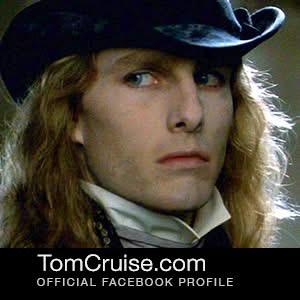 His first major break came when he moved to New York City at 18 with dreams of becoming an actor. He supported himself with odd jobs, including being a busboy, while attending auditions. His persistence paid off when he landed a small role in the 1981 film Endless Love. That same year, he appeared in Taps, a military school drama that allowed him to display his intensity and emotional depth. Critics took notice, and so did the film industry.
His first major break came when he moved to New York City at 18 with dreams of becoming an actor. He supported himself with odd jobs, including being a busboy, while attending auditions. His persistence paid off when he landed a small role in the 1981 film Endless Love. That same year, he appeared in Taps, a military school drama that allowed him to display his intensity and emotional depth. Critics took notice, and so did the film industry.
In 1983, Cruise’s career catapulted into stardom with Risky Business. The image of a young man sliding across the floor in socks and underwear became iconic. Audiences were captivated by his charisma, energy, and rebellious charm. He was no longer just a young actor with potential; he was a full-fledged movie star.
Over the next few years, he carefully selected roles that would expand his range and solidify his status. He starred in All the Right Moves (1983), Legend (1985), and most notably, Top Gun in 1986. As the cocky and daring Navy pilot Pete “Maverick” Mitchell, Cruise became an international sensation. The film grossed over $350 million worldwide and forever linked his name with high-octane thrill and confidence.
But Cruise was determined to prove he was more than a pretty face in a fighter jet. He turned to more serious, complex roles. In The Color of Money (1986), he held his own opposite Paul Newman. Rain Man (1988), where he starred alongside Dustin Hoffman, was a critical and commercial success, winning the Academy Award for Best Picture. Cruise’s portrayal of the selfish and fast-talking Charlie Babbitt revealed a capacity for emotional nuance and transformation. He was no longer just a star; he was an actor.
In 1989, he took on perhaps his most challenging role to date in Born on the Fourth of July, portraying real-life Vietnam War veteran Ron Kovic. Cruise spent months preparing for the role, meeting with Kovic and even training to move in a wheelchair. The performance earned him his first Academy Award nomination and won him a Golden Globe. This was a turning point—proof to Hollywood and the world that he was willing to dig deep for his craft.
As the 1990s unfolded, Cruise remained on top. He starred in Days of Thunder (1990), during which he met his second wife, Nicole Kidman. The two became one of Hollywood’s most talked-about couples, starring together in Far and Away (1992) and later Eyes Wide Shut (1999). His marriage to Kidman would last until 2001, but during those years, Cruise’s career continued its meteoric rise.
He took on roles in high-stakes dramas like A Few Good Men (1992), where he famously sparred with Jack Nicholson in the courtroom, delivering the line: “I want the truth!” The film was a hit and cemented his image as both a box office draw and a dependable dramatic actor. The Firm (1993), based on the John Grisham novel, and Interview with the Vampire (1994), where he played the undead Lestat, showed his willingness to experiment with diverse genres and characters.
Perhaps one of the defining moments of his career came in 1996 with the release of Mission: Impossible. As Ethan Hunt, Cruise blended action with espionage, launching what would become one of the most successful film franchises in history. He not only starred but also produced the film, demonstrating his commitment to creative control and his knack for business. The success of Mission: Impossible expanded Cruise’s reputation as a leading man who could also command the behind-the-scenes machinery of Hollywood.
That same year, he starred in Jerry Maguire, a romantic comedy-drama that earned him his second Oscar nomination. His portrayal of a sports agent going through a moral awakening resonated deeply with audiences. The film’s catchphrases—“Show me the money!” and “You had me at hello”—became part of pop culture. Cruise’s performance was heartfelt, funny, and deeply human.
By the late 1990s and early 2000s, Tom Cruise was a global icon. Yet, behind the scenes, his personal life was under increasing scrutiny. His involvement with the Church of Scientology, which he joined in the late 1980s, began to draw media attention. Cruise was passionate about his beliefs, crediting Scientology with helping him overcome dyslexia and find personal empowerment. But the public reaction was mixed, and over time, his outspokenness on the subject would generate controversy.
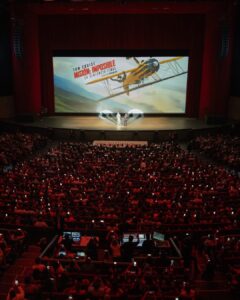
His marriage to Nicole Kidman ended in 2001, and shortly after, he began a relationship with actress Penélope Cruz, whom he met on the set of Vanilla Sky (2001). Though the relationship was short-lived, Cruise’s professional life remained strong. He continued taking on roles that challenged him—like in Minority Report (2002), a sci-fi thriller directed by Steven Spielberg that was both visionary and commercially successful.
The following years saw Cruise navigating both professional triumphs and personal turbulence. His couch-jumping moment on The Oprah Winfrey Show in 2005, where he expressed his love for actress Katie Holmes, sparked media frenzy. While many saw it as a display of genuine emotion, others viewed it as erratic behavior. His heated interview with Matt Lauer on the Today Show, where he criticized psychiatry and the use of antidepressants, further complicated his public image.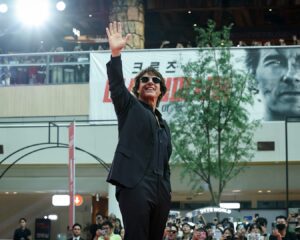
Nonetheless, Cruise’s work remained compelling. In 2004, he delivered a chilling performance in Collateral, playing a hitman opposite Jamie Foxx. It was one of the few times he portrayed a villain, and he did so with icy precision. His performance was widely praised, once again proving his range.
By the mid-2000s, Tom Cruise had become a paradox—one of the most bankable stars in the world, yet constantly navigating waves of media attention that threatened to overshadow his professional accomplishments. In 2005, shortly after the media whirlwind surrounding his relationship with Katie Holmes and his spirited defense of Scientology, Cruise starred in War of the Worlds, directed by Steven Spielberg. The film was a commercial success, grossing over $600 million worldwide. It reaffirmed his ability to draw crowds, even as the media narrative around him became more complicated.
In 2006, Cruise and Holmes welcomed their daughter, Suri Cruise, into the world. The birth of their daughter became an international event. Paparazzi followed the family relentlessly, and photos of Suri were splashed across magazine covers globally. Later that year, the couple married in an elaborate ceremony at a 15th-century castle in Italy, attended by A-list celebrities and high-profile Scientology figures. For a time, they seemed like Hollywood royalty.
Professionally, Cruise continued to lead the Mission: Impossible franchise. Mission: Impossible III, directed by J.J. Abrams and released in 2006, introduced a darker tone and more personal stakes for Ethan Hunt. While it didn’t perform quite as well as previous entries, it laid the foundation for a franchise resurgence in the following decade.
However, 2006 also marked a turning point in Cruise’s relationship with Paramount Pictures. After years of partnership, the studio ended their deal with Cruise/Wagner Productions, citing his controversial behavior and outspoken views. It was a blow, but Cruise responded by joining forces with investors to revive United Artists, taking a bold step into the world of studio management and independent production.
His first major release under the United Artists banner was Lions for Lambs (2007), a politically charged drama starring Cruise, Meryl Streep, and Robert Redford. The film aimed to tackle the complexities of modern warfare and political responsibility, but it failed to connect with audiences or critics. Still, Cruise remained undeterred.
In 2008, he stunned audiences with a complete departure from his typical roles: playing the balding, foul-mouthed studio executive Les Grossman in Tropic Thunder. His performance was outrageous, hilarious, and completely unexpected. The role earned him a Golden Globe nomination and reminded the world of his ability to laugh at himself—and break type in a big way.
As the 2010s arrived, Cruise doubled down on his strength as an action icon. Knight and Day (2010), in which he starred alongside Cameron Diaz, combined comedy, romance, and action, though it received mixed reviews. But Cruise’s reputation for performing his own stunts was growing. He was no longer just playing action heroes; he was physically becoming one.
The tide truly turned with Mission: Impossible – Ghost Protocol (2011). The film, directed by Brad Bird, reignited the franchise with breathtaking set pieces, including Cruise scaling the Burj Khalifa—the tallest building in the world—without a stunt double. Audiences were mesmerized by the sheer audacity of the performance, and the film grossed nearly $700 million globally. It was a career renaissance.
That same year, Cruise took on the role of rock star Stacee Jaxx in Rock of Ages (2012), displaying an entirely different side of himself. While the musical itself was divisive, Cruise’s performance was magnetic. He embodied the hedonistic and damaged soul of a rock icon with a surprising degree of vulnerability and charm.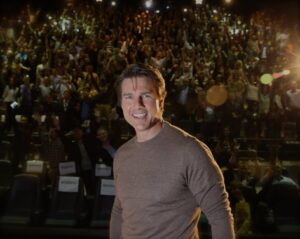
In 2013, he starred in the science fiction film Oblivion, directed by Joseph Kosinski. Set in a post-apocalyptic future, Cruise’s portrayal of a lone drone repairman questioning the nature of his reality was praised for its emotional depth. Visually stunning and intellectually engaging, Oblivion added another dimension to Cruise’s sci-fi portfolio.
But it was Edge of Tomorrow (2014), a sci-fi action film directed by Doug Liman, that captured audiences and critics alike. Cruise played Major William Cage, a military public affairs officer thrown into battle against an alien invasion—and forced to relive the same day over and over. The film’s innovative narrative and Cruise’s uncharacteristically vulnerable performance marked it as a modern classic. Co-starring Emily Blunt, the film became a fan favorite and a testament to Cruise’s willingness to evolve within the action genre.
Cruise continued to lead the Mission: Impossible franchise into new heights with Rogue Nation (2015) and Fallout (2018). In Rogue Nation, he performed a stunt that involved hanging off the side of a military aircraft during takeoff—again, without a stunt double. The commitment was real. In Fallout, he broke his ankle performing a rooftop jump but continued shooting the scene. These feats only added to his legend. The films were critical and commercial triumphs, with Fallout often cited as the best in the series.
Amid his professional highs, Cruise’s personal life remained largely private. He and Katie Holmes divorced in 2012, and she retained primary custody of Suri. Cruise’s relationship with Suri became the subject of intense media speculation, with reports suggesting they had become estranged. However, Cruise remained focused on his career, rarely speaking publicly about his family life.
As the 2020s approached, Cruise prepared for what many believed to be his most ambitious cinematic moment yet. He would return to the skies in Top Gun: Maverick, the long-awaited sequel to his 1986 blockbuster. Originally set for release in 2020, the film was delayed multiple times due to the COVID-19 pandemic. When it finally premiered in 2022, it was nothing short of a sensation.
Top Gun: Maverick was a heartfelt, high-octane tribute to the original, while also introducing a new generation of pilots. Cruise, at nearly 60 years old, performed many of the flight sequences himself, flying in real F/A-18 Super Hornets. The film received widespread critical acclaim and earned over $1.4 billion globally, becoming the highest-grossing film of Cruise’s career and one of the top box office hits of the decade.
The film wasn’t just a box office success—it was a cultural event. It reminded audiences why Cruise was one of the last true movie stars in an era increasingly dominated by franchises and digital effects. In an age of green screens, Cruise remained the real deal: jumping out of planes, flying jets, and risking it all for the authenticity of the experience.
He used the success of Top Gun: Maverick to build momentum for the next installments of the Mission: Impossible saga. In 2023, Mission: Impossible – Dead Reckoning Part One hit theaters, with Part Two already in production. Cruise continued to push boundaries, this time filming stunts involving motorcycles driving off cliffs, trains crashing in the Alps, and even plans to shoot scenes in outer space.
By this time, Cruise was more than a movie star—he was a cinematic daredevil, a producer, and a symbol of Hollywood’s golden age. Despite being one of the most famous faces in the world, he maintained a mysterious aura. He had no official social media accounts, rarely gave interviews, and largely kept his private life separate from his public persona.
Financially, Tom Cruise’s empire had grown exponentially. With backend deals, producer credits, and a consistent box office presence, his net worth soared. As of 2025, Cruise’s estimated net worth is over $600 million. He owns several properties, including homes in Beverly Hills, Colorado, and the United Kingdom. He’s also a licensed pilot and owns a fleet of aircraft, often flying himself to film sets around the world.
What sets Cruise apart is not just his longevity but his relentless pursuit of excellence. He’s known on set for his discipline, intensity, and attention to detail. Cast and crew often speak of his generosity and focus, though some also mention his perfectionism and high expectations. Still, few dispute his work ethic or the fact that he gives everything to each role he takes on.
As the world settled into a post-pandemic rhythm, Tom Cruise found himself at the center of a renewed appreciation for cinematic spectacle. While streaming platforms reshaped the film industry, Cruise remained committed to the traditional moviegoing experience. He was vocal in his belief that some films were meant to be seen in theaters—on the biggest screens possible, with immersive sound and shared reactions. For him, cinema wasn’t just entertainment; it was a communal art form.
This passion was on full display during the promotion of Top Gun: Maverick. Cruise attended premieres around the globe, greeting fans, thanking military personnel, and engaging in stunts that left audiences both thrilled and incredulous. In one now-famous promotional video, he stood on the wing of a biplane mid-flight, casually addressing viewers about the upcoming Mission: Impossible sequel. It wasn’t CGI. It wasn’t a stuntman. It was Tom Cruise—still pushing limits, still defying age and fear.
While many stars of his era faded into supporting roles or retired altogether, Cruise doubled down. At over sixty years old, he remained at the peak of physical fitness, training relentlessly to perform the grueling action sequences that defined his films. Whether it was halo jumps from aircraft at 25,000 feet, precision motorcycle chases across rugged terrain, or underwater sequences requiring minutes-long breath holds, Cruise tackled each with the enthusiasm of a man half his age.
Yet beneath the stunts and the sunglasses, there remained the same driven, passionate kid from Syracuse who once struggled with dyslexia and dreamed of making something more of his life. Acting was never just a job for him—it was a calling, a discipline, and, at times, a mission. He studied characters obsessively, rehearsed scenes with laser focus, and treated each film as an opportunity to push the boundaries of performance and production.
His reputation in the industry, while occasionally marked by controversy, was ultimately one of deep respect. Directors praised his commitment. Co-stars noted his generosity. He was known to learn everyone’s name on set, from grips to caterers, and often stayed long after wrap to help with minor details or simply to thank the crew. His intense approach could be intimidating, but few denied that he made those around him better.
Cruise also used his position to mentor younger actors and filmmakers. Many who worked with him spoke of how he demystified the craft, offering insights into everything from screen presence to post-production editing. While he never formally taught, his sets became informal classrooms—places where discipline and inspiration converged.
His legacy extended beyond the screen. Cruise became emblematic of a kind of cinematic ideal: the larger-than-life hero who wasn’t created in a digital effects lab but who earned every punch, leap, and gasp. He made audiences believe again—not just in his characters, but in the power of movies themselves.
And yet, despite his status, Cruise remained elusive in many ways. He rarely discussed his private life, especially in the wake of his divorce from Katie Holmes and his estrangement from his daughter Suri. Questions about his ties to Scientology remained persistent, but Cruise rarely addressed them publicly, choosing instead to focus on his work. Whether this was a strategic silence or a deeply held belief in keeping his personal and public lives separate, it added to the mystique that had surrounded him for decades.
Throughout the 2020s, Cruise also quietly expanded his influence behind the scenes. Through his production company, he helped finance and develop not only his own films but also projects for emerging directors. He invested in theatrical technologies, pushing for more immersive experiences and better sound systems in cinemas. In an age of quick content and digital saturation, Cruise stood as a defender of quality, craft, and the kind of films that left you breathless.
His real-life adventures mirrored those of his on-screen alter egos. He learned to fly fighter jets, scaled skyscrapers, and even prepared for a groundbreaking cinematic venture—shooting a narrative film in outer space, in collaboration with NASA and SpaceX. No actor had ever done it before. But if anyone could, it would be Tom Cruise. It was less about spectacle and more about discovery, about what was possible in the marriage of art and human achievement.
Financially, Cruise had long surpassed the status of a millionaire. His strategic backend deals—especially for Top Gun: Maverick, where he reportedly took a reduced upfront salary in exchange for a share of the profits—earned him over $100 million from that film alone. Add in decades of box office hits, real estate holdings, private jets, and producing credits, and his estimated net worth exceeded $600 million by 2025.
Yet money was never the driver. From the beginning, Cruise had pursued something deeper: mastery, transformation, connection. Each role wasn’t just another job—it was a chance to challenge himself, to disappear into a new identity, and to make audiences feel something powerful.
He often said that he wanted to give people their money’s worth, to earn their time and trust. And he did—again and again, over more than forty years.
Even in quieter moments, away from the cameras and interviews, Cruise remained a student of his craft. He studied old films, met with stunt teams, and engaged in long discussions about narrative arcs and cinematic philosophy. Fame, for him, was never the goal—it was the byproduct of dedication. He didn’t want to be famous; he wanted to be great.
As he looked toward the future, Cruise showed no signs of slowing down. New Mission: Impossible installments were already in development. Rumors swirled about him producing historical dramas, returning to science fiction, or even taking on a directorial debut. He’d long expressed interest in shaping stories from behind the lens, and many believed it was only a matter of time before he stepped fully into that role.
But whether in front of the camera or behind it, one thing was certain: Tom Cruise had become a permanent part of cinematic history. Few actors had ever matched his combination of star power, work ethic, and daring. Fewer still had sustained that level of relevance for so long in such a volatile industry.
He represented a bygone era, perhaps—but also a timeless one. In every frame, there was a glint of that same 21-year-old who danced through Risky Business, the pilot who flew through the danger zone, the agent who ran across rooftops, the man who never stopped running toward something greater.
Tom Cruise wasn’t just a movie star. He was a symbol of commitment, fearlessness, and the relentless pursuit of excellence. And as long as there were stories to tell, risks to take, and audiences willing to believe, he would be there—running, flying, diving, and defying expectations.
In the end, the story of Tom Cruise wasn’t just one of fame or fortune. It was a story of transformation. Of a boy from a broken home who turned his struggles into strength, who transformed himself into an icon not through luck or privilege, but through grit, discipline, and a dream that never wavered.
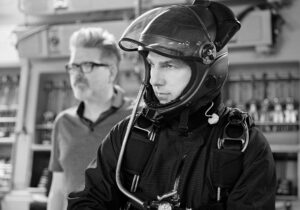
His life remains an unfolding mission—one not yet impossible.